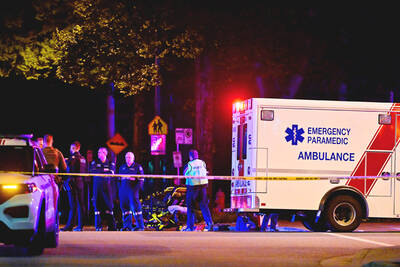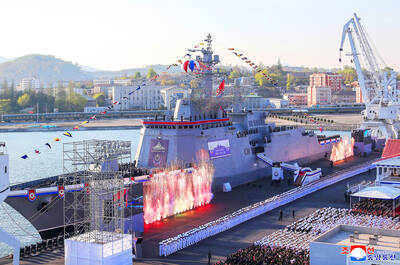Americans shook off economic uncertainty and gave a record US$306.4 billion to charitable causes last year, an increase of 3.9 percent for the year, a survey showed yesterday.
The annual survey by Giving USA Foundation and the Center on Philanthropy at Indiana University showed a rise in overall donations but hesitation by individual donors and companies affected by economic woes.
George Ruotolo, chair of the Giving Institute, said charitable contributions held up even with Americans fretting about high oil prices, the subprime real estate crisis and the ongoing war in Iraq.
“People don’t appear to be panicking, they feel that it’s going to be OK in 2008,” Ruotolo said.
“I’m not bullish but I am satisfied. Even when you adjust for inflation giving still was on the plus side in 2007,” he said.
The overall total is up just 1 percent when adjusted for inflation. It also represents 2.1 percent of US gross domestic product.
Ruotolo said that there were few instances in recent years where giving declines in current dollars, although during some downturns there was a drop after adjustment for inflation.
Based on that, he said: “History would tell us we’re not in a recession.”
Some categories of giving showed slow growth.
Individual giving, the mainstay of fundraising and charity, increased 2.7 percent — a drop of 0.1 percent adjusted for inflation — to an estimated US$229 billion, or some three-fourths of the total.
Corporate gifts, closely tied to corporate profits, rose 1.9 percent to US$15.69 billion, a decline of 0.9 percent after adjusting for inflation.
The rise in giving was led by foundation grants, up 10.3 percent to US$38.5 billion. Charitable bequests were up 6.9 percent to US$23.1 billion.
Despite the positive trend last year, there are concerns about the outlook for this year, during which time economic conditions have worsened and many Americans are focused on the presidential campaign, gifts to which are not included in the overall charity total.
“Charities we surveyed have concerns about 2008 for the economy and the stock market and the impact they will have on giving, but not about the presidential election,” said Del Martin, chair of Giving USA Foundation.
According to the survey, presidential campaigns raised US$580 million last year — less than one-quarter of 1 percent of the US$306 billion raised for charitable purposes.
Measured by category of recipients, religious organizations received an estimated US$102.3 billion or 33.4 percent of the total. That was a 4.7 percent increase from 2006 levels.
Educational organizations got an estimated US$43.3 billion, or 14.1 percent of the total. This was up 6.4 percent from the prior year.
Gifts to human services charities rose 8.4 percent for the year to US$29.64 billion.
Health organizations saw a 5.4 percent rise to US$23.15 billion and donations to arts and culture groups rose 7.8 percent to US$13.67 billion.
Strong growth was seen in contributions to international organizations that provide relief, economic aid, exchange, and other programs. Donations rose 16.1 percent to US$13.22 billion amid what study authors said was increased awareness, especially among people born after 1981, of global issues.
A big question looking ahead for philanthropy is to what degree individuals and companies will cut back because of real or anticipated economic troubles.
The American Red Cross said this month it was low on cash and struggling to provide aid to disaster victims following a string of weather-related calamities in the US.

Archeologists in Peru on Thursday said they found the 5,000-year-old remains of a noblewoman at the sacred city of Caral, revealing the important role played by women in the oldest center of civilization in the Americas. “What has been discovered corresponds to a woman who apparently had elevated status, an elite woman,” archeologist David Palomino said. The mummy was found in Aspero, a sacred site within the city of Caral that was a garbage dump for more than 30 years until becoming an archeological site in the 1990s. Palomino said the carefully preserved remains, dating to 3,000BC, contained skin, part of the

TRUMP EFFECT: The win capped one of the most dramatic turnarounds in Canadian political history after the Conservatives had led the Liberals by more than 20 points Canadian Prime Minister Mark Carney yesterday pledged to win US President Donald Trump’s trade war after winning Canada’s election and leading his Liberal Party to another term in power. Following a campaign dominated by Trump’s tariffs and annexation threats, Carney promised to chart “a new path forward” in a world “fundamentally changed” by a US that is newly hostile to free trade. “We are over the shock of the American betrayal, but we should never forget the lessons,” said Carney, who led the central banks of Canada and the UK before entering politics earlier this year. “We will win this trade war and

‘BODIES EVERYWHERE’: The incident occurred at a Filipino festival celebrating an anti-colonial leader, with the driver described as a ‘lone suspect’ known to police Canadian police arrested a man on Saturday after a car plowed into a street party in the western Canadian city of Vancouver, killing a number of people. Authorities said the incident happened shortly after 8pm in Vancouver’s Sunset on Fraser neighborhood as members of the Filipino community gathered to celebrate Lapu Lapu Day. The festival, which commemorates a Filipino anti-colonial leader from the 16th century, falls this year on the weekend before Canada’s election. A 30-year-old local man was arrested at the scene, Vancouver police wrote on X. The driver was a “lone suspect” known to police, a police spokesperson told journalists at the

North Korean leader Kim Jong-un has unveiled a new naval destroyer, claiming it as a significant advancement toward his goal of expanding the operational range and preemptive strike capabilities of his nuclear-armed military, state media said yesterday. North Korea’s state-run Korean Central News Agency (KCNA) said Kim attended the launching ceremony for the 5,000-tonne warship on Friday at the western port of Nampo. Kim framed the arms buildup as a response to perceived threats from the US and its allies in Asia, who have been expanding joint military exercises amid rising tensions over the North’s nuclear program. He added that the acquisition